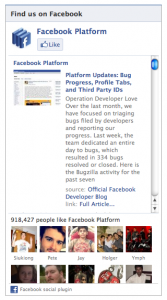Three tips for designing a more LIKE-able website homepage
If one of your goals for this year or next is to build your online Facebook community, then you’ve already put some forethought into how you want to integrate Facebook into your homepage.
Ideally, your existing user-base is what you’d want to use to launch your new Facebook page because it gives your community a foundation of active users that will encourage new users to “like” it. However, I’ve seen plenty of companies that start their Facebook page as a stand-alone community used to “test the waters” and have practically forgotten to invite their entire email subscriber list and web audience to the part.
If you’re already doing a great job building an online community with Facebook, just consider how much larger it will grow once you start showing it off to your existing user base.
There are several tools you should get to know if you’re going to start integrating Facebook into your website:
![]() Facebook Like Button – This button allows a user to quickly and easily share a page (landing page perhaps) with their friends on Facebook. The most obvious advantage to this button is that you’re encouraging people to share your content. The less obvious advantage is that you’re also enabling them to share your content by making it easy, thus making the whole act much more streamlined. Facebook Insights will also offer you analytics for this button.
Facebook Like Button – This button allows a user to quickly and easily share a page (landing page perhaps) with their friends on Facebook. The most obvious advantage to this button is that you’re encouraging people to share your content. The less obvious advantage is that you’re also enabling them to share your content by making it easy, thus making the whole act much more streamlined. Facebook Insights will also offer you analytics for this button.
[text_ad]
 Facebook Share Button – Facebook doesn’t recommend this for “new developers”, but it’s lucky that we’ve got a pretty simple plugin for WordPress that will do basically the same thing called Facebook Share (New) Button. This button lets people easily share your articles on Facebook. It differs from the Like Button, which can easily be installed on a single page, whereas this button is installed on all of your articles and keeps track of how many people like a single article.
Facebook Share Button – Facebook doesn’t recommend this for “new developers”, but it’s lucky that we’ve got a pretty simple plugin for WordPress that will do basically the same thing called Facebook Share (New) Button. This button lets people easily share your articles on Facebook. It differs from the Like Button, which can easily be installed on a single page, whereas this button is installed on all of your articles and keeps track of how many people like a single article.
 Like Box – I call this the “show-off” plugin, but if you already have a community on Facebook, this is a great tool that will encourage new users to join your community.
Like Box – I call this the “show-off” plugin, but if you already have a community on Facebook, this is a great tool that will encourage new users to join your community.
It tells people which articles others like on your site and also displays a showcase of other people who already “like” your Facebook page. It’s also the most direct way to ask for a “like” on Facebook, because it’s engineered to get people to hit the “like” button.
If you’re wondering how “that other publishing company” is doing “that thing” with their Facebook integration, check out Facebook’s list of publishers who have hired developers to build seamless applications between Facebook and their websites.


